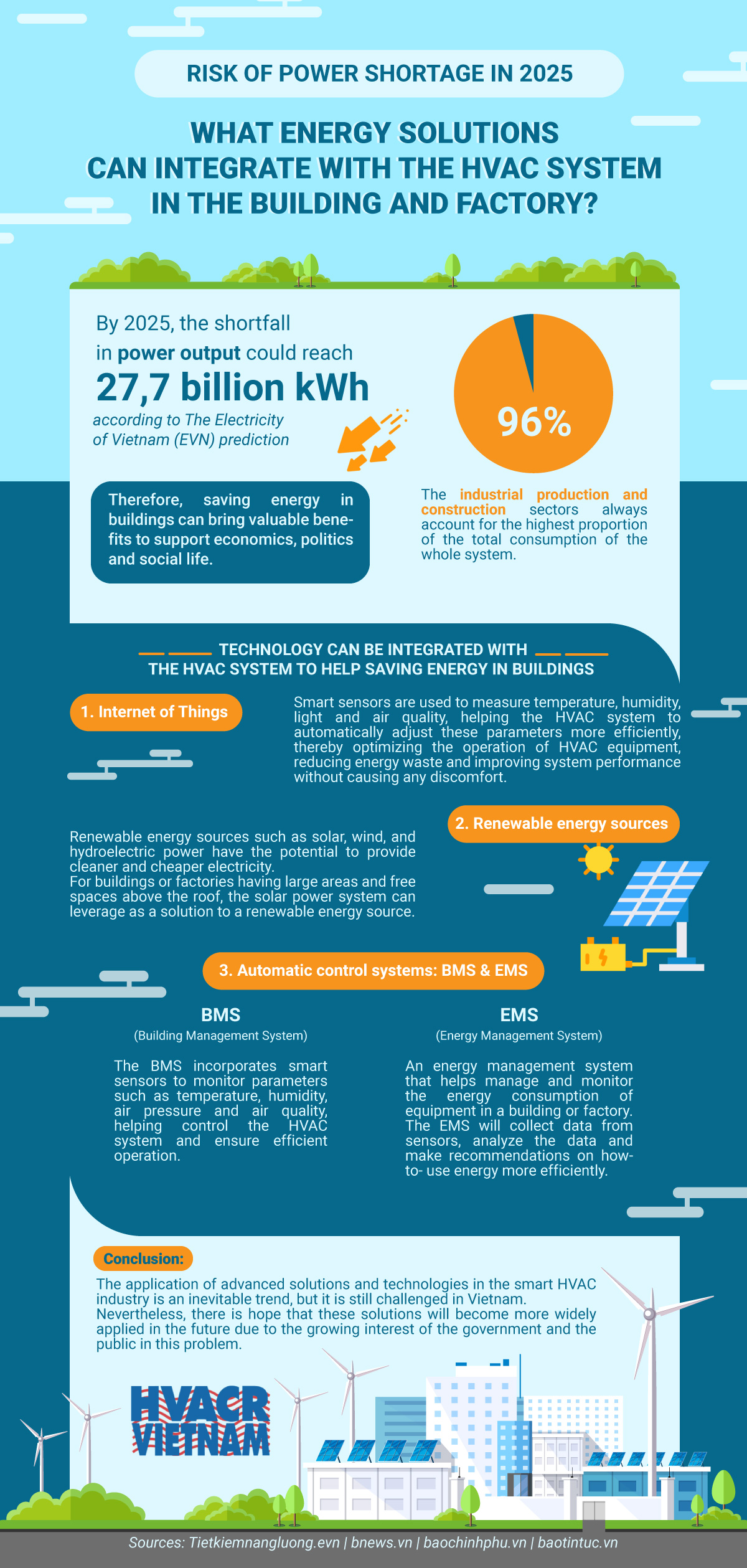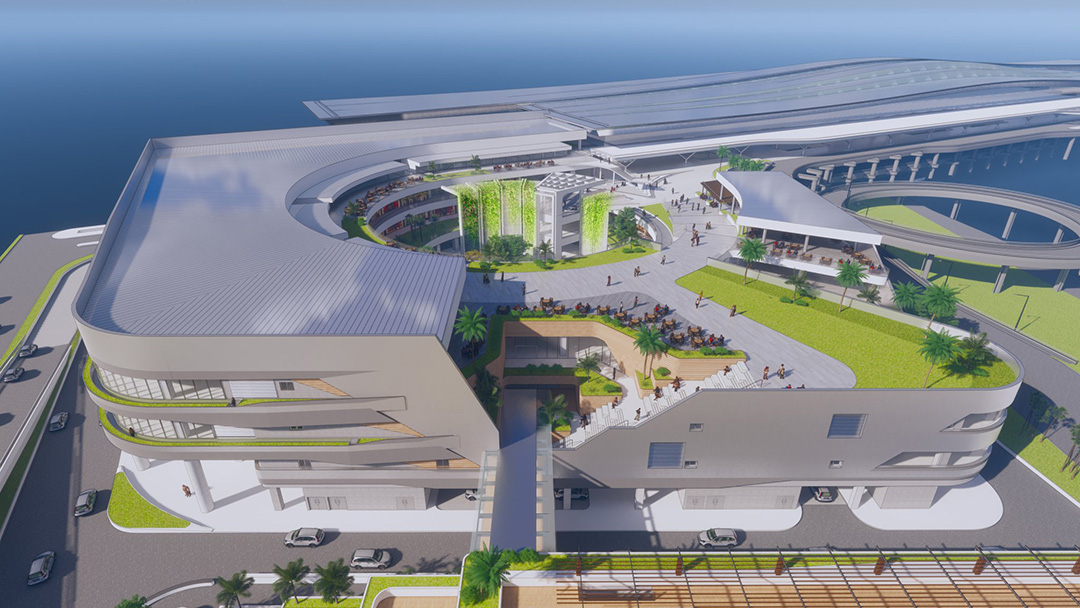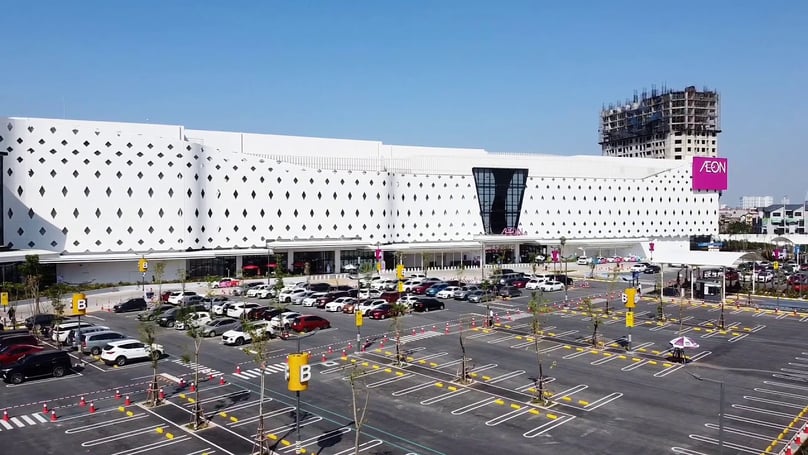[INFOGRAPHIC] Risk of power shortage in 2025. What energy solutions can integrate with the HVAC system in the building and factory?
The Electricity of Vietnam (EVN) has estimated that the shortfall in power output could reach 27.7 billion kWh by 2025. VietinBank Securities has forecasted the risk of power shortage from 2023 to 2025 due to the sharp increase in electricity consumption demand in Vietnam, of which the industrial production and construction sectors always account for the highest proportion – nearly 96% of the total consumption of the whole system.
Statistics from the Center for Energy Saving of Ho Chi Minh City reveal that in buildings, the air conditioners use a high volume of energy, accounting for over 70% of the total energy used; lighting accounts for 10%; other types of equipment like office machinery, elevators, water pumps account for about 20%. Therefore, saving energy in buildings can bring valuable benefits to support economics, politics and social life.
Through actual research, an efficiently designed building can save 30% of electricity volume and 30 – 50% of water use, simultaneously reduce 35 % of CO2 emissions and 50-90% reduction of other types of waste.
To meet the demand for energy efficiency, businesses and organizations have sought to optimize intelligent HVAC systems.
To save energy in buildings, and factories, what technology can be integrated with the HVAC system?
Internet of Things – Smart energy saving in buildings and factories
IoT and AI are leading solutions integrated into HVAC systems to manage and save energy for buildings and factories. Specifically, smart sensors are used to measure temperature, humidity, light and air quality, helping the HVAC system to automatically adjust these parameters more efficiently, thereby optimizing the operation of HVAC equipment, reducing energy waste and improving system performance without causing any discomfort.
The IoT-enabled monitoring system can also give early warnings about the condition of the vibration or temperature of the electric motor. This feature will limit the damage that leads to unplanned production stoppage and emergency repair.
Renewable energy sources are encouraged to use
Using renewable energy sources is a solution to reduce energy consumption and save costs for a building or factory. Renewable energy sources such as solar, wind, and hydroelectric power have the potential to provide cleaner and cheaper electricity.
For buildings or factories having large areas and free spaces above the roof, the solar power system can leverage as a solution to a renewable energy source. Solar power systems provide electricity to devices in the building, hence, making HVAC operations more efficient and reducing electricity costs.
Optimize the configuration and operation schedule of the HVAC system with several automatic control systems BMS & EMS
- BMS (Building Management System): A building management system that provides management features for equipment in a building or factory. BMS is used to manage HVAC, lighting, security and other devices, ensuring the correct, timely, efficient, energy-efficient operation of equipment in the building and saving operating costs. The BMS incorporates smart sensors to monitor parameters such as temperature, humidity, air pressure and air quality, helping control the HVAC system and ensure efficient operation.
- EMS (Energy Management System): An energy management system that helps manage and monitor the energy consumption of equipment in a building or factory. An EMS system can effectively manage building energy owing to the combination of conventional building energy management functions with additional intelligent functions. The EMS will collect data from sensors, analyze the data and make recommendations on how-to-use energy more efficiently.
Vietnam is transitioning from an agrarian economy to an industrial and service economy. So the energy demand is increasing, especially in buildings and manufacturing plants. The Hanoi Electricity Corporation (EVNHANOI) has called for businesses to accompany to save at least 2.2% of the total electricity in 2023. Accordingly, the office building group is expected to save 5% of the total electricity consumed in the year, and manufacturers need to save at least 2% of electricity per product this year.
However, presently, the application of energy-saving and energy management solutions is still limited in many buildings and factories in Vietnam.
New buildings and factories are constructed with energy efficiency and energy management solutions in mind. However, there still have many limitations in terms of HVAC systems in old buildings. Upgrading the HVAC system to use new energy-saving equipment and adopting other energy-saving solutions is still not widely available.
Energy management solutions, including BMS and EMS systems, are also being implemented in some buildings and factories in Vietnam, but there is still a limitation in the knowledge and experience of managers.
Meanwhile, leveraging renewable energy sources such as solar and wind power is encouraged in many localities nationwide. However, the initial investment costs for these systems are high, resulting in this solution not being widely adopted.
In short, the application of advanced solutions and technologies in the smart HVAC industry is an inevitable trend, but it is still challenged in Vietnam. Nevertheless, there is hope that these solutions will become more widely applied in the future due to the growing interest of the government and the public in this problem.






